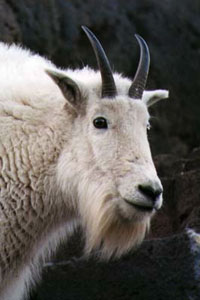
NatureMapping Animal Facts
Mountain Goat
|
Mountain Goat (Oreamnos americanus) 
Description: The Mountain Goat is a large mammal covered with long creamy white hair to keep the goat warm in the winter months (see photos). Their cryptically colored coat matches the snow and keeps it hidden from predators. They shed their thick fur in the warmer months by rubbing up against trees. They have black lips, nostrils, hooves and horns.
Adults have long hair under their throat forming a "beard" that may be up to 5 inches long (125 mm). Both sexes have sharp pointed horns that curve up and slightly backward, in females the horns reach 9 inches (230 mm) in males about 12 inches (300 mm). Their hooves are well adapted to their living on cliffs and ledges, they have a hard, straight outer margin, with soft and flexible inner pads that provide excellent traction on rocky cliffs. They stand about 3 to 3 ½ feet (90 to 100 cm) at the shoulder and weigh between 100 and 300 pounds (455-135 kg). Females are about 15% smaller than the males.
Range / Habitat: Core zones are Mountain Hemlock, Silver Fir, Subalpine Fir, Alpine/Parkland, and High Lava Flows. Steep, rugged topography is as important as vegetation to Mountain Goats. Lower zones may be adequate for them if they are near steep slopes and the higher core zones. Click the range map to learn more about the distribution of Mountain Goats in Washington. Diet: Mountain goats graze on grasses and forbs in summer. They also browse on shrubs and conifers. Their diet is variable in the winter when they feed on mosses, lichens, grasses, shrubs, and conifers. Behavior: Mountain Goats are the very agile mountain mammals and they move confidently on rocky ledges where they are safe from predators. Reproduction: Mountain goats mate in November, but the rutting season can last into December or January.
Did you know?
 
Adult Mountain Goat
More information: WPZ - Mountain Goat Facts
|

